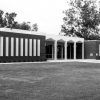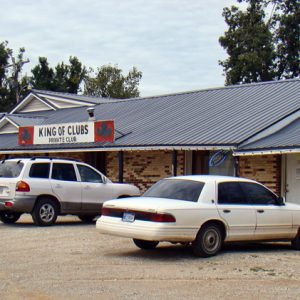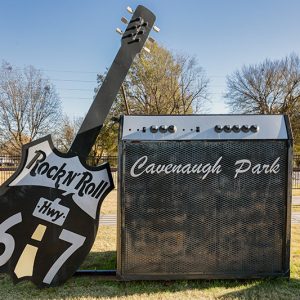calsfoundation@cals.org
Rock 'n' Roll Highway 67
Rock ’n’ Roll Highway 67 is a segment of U.S. Highway 67 running approximately 111 miles through White, Jackson, Lawrence, and Randolph counties in northeastern Arkansas, with a portion in Miller County in southwestern Arkansas. Its name is derived from the rockabilly music performed at nightclubs and other venues located on the highway by legendary progenitors of the genre. The designation by Act 497 of the Eighty-seventh Arkansas General Assembly in 2009 has since spawned music festivals, museum exhibits, and plaques in communities situated along the highway.
The term “rockabilly”—a portmanteau of “rock ’n’ roll” and “hillbilly”—is defined as a mixture of blues, country and western, and rhythm and blues music that saw its biggest popularity beginning in the post–World War II era and lasting until around the time of the so-called British Invasion of the early 1960s. Original rockabilly artists included Elvis Presley, Roy Orbison, and Jerry Lee Lewis, along with noted Arkansans Johnny Cash, Conway Twitty, Sonny Burgess, and Billy Lee Riley. These same musicians are cited as influences by later musical legends—ranging from the Beatles to Bob Dylan—who credit rockabilly as an inspiration for their own distinctive styles of music. Establishments located on U.S. 67 that hosted these acts included Bob King’s King of Clubs in Swifton (Jackson County), the Silver Moon Club in Newport (Jackson County), the rooftop of the Skylark Drive-In Theater in Pocahontas (Randolph County), and the Oasis Club and the Wagon Wheel in Bald Knob (White County), among others.
The idea to honor the road originated in 2005 with noted Pocahontas musician Gary Gazaway (who has performed and recorded with the likes of Stevie Ray Vaughan, Steve Winwood, Joe Cocker, and Phish). As a lifelong resident of the area, Gazaway had long recognized the significance of the highway as a musical artery. He suggested the idea to director of the Arkansas Folklife Program at Arkansas State University (ASU) Michael Luster and to music historian Stephen Koch, co-founder and host of the radio program Arkansongs. All three concluded that it was a worthy project and agreed that the highway should be called the “Rockabilly Highway.” Gazaway advanced his idea for the designation during the three-week Pocahontas Sesquicentennial celebration in 2006—the highlight of which was a performance by Billy Lee Riley and Sonny Burgess.
The original idea was for the highway to run from Bald Knob to the Missouri state line north of Corning (Clay County). A committee was formed that included representatives from the counties through which the highway would pass, as well as others such as Michael Luster of ASU, state representative J. R. Rogers of Walnut Ridge (Lawrence County), and Little Rock (Pulaski County) author Marvin Schwartz, the committee’s director.
The committee was soon divided over the name. Gazaway and the historians favored the “Rockabilly Highway” designation, while the politicians and civic boosters did not want any association with the perceived pejorative term “hillbilly,” proposing instead the name “Rock ’n’ Roll Highway 67.” The committee ultimately voted 8–5 in favor of naming it Rock ’n’ Roll Highway 67. Gazaway disagreed with the decision, saying that the name dishonors the historical aspect of the road: “Rockabilly was the kind of music they played there,” he said. “The hillbilly culture is what made the music. To call it anything else is to go against the historical aspect of it.” Giving a nod to the naming controversy, the legislation reads, “While academics and historians have indicated that a change in the name of this music to ‘rockabilly’ should be made, everyone who lived, breathed, and rocked during this time called the music rock ’n’ roll.”
After Governor Mike Beebe signed legislation for the highway designation, which was sponsored by Representative Rogers, on March 20, 2009, there was growing effort to capitalize on the designation by civic boosters eager to attract tourists to their communities. For example, Walnut Ridge—where the rockabilly-influenced Beatles stopped briefly at the municipal airport in 1964 en route to a vacation destination in Missouri—started a Beatles-themed music festival called Beatles at the Ridge (tag line: “Where Abbey Road Meets the Rock ’n’ Roll Highway!), erected a life-sized sculpture depicting the Beatles from the cover of their landmark album Abbey Road, and created the Walnut Ridge Guitar Walk—a colored concrete walkway in the shape of an Epiphone Casino electric guitar popular with musicians of the era. The walk includes ten stations with recorded information, narrated by Sonny Burgess, about musicians who traveled the highway. Also, highway signs reading ROCK ’N’ ROLL HIGHWAY 67 can be seen lining the route.
The original legislation creating the highway covered only Jackson, Lawrence, and Randolph counties. In October 2011, signs were installed by what is now the Arkansas Department of Transportation marking a portion of Highway 67 through Texarkana (Miller County) as part of the Rock ’n’ Roll Highway. Early rock and roll performers sometimes played at Arkansas Municipal Auditorium when they traveled through Texarkana on Highway 67. Act 26 of 2013 added White County portion of Highway 67 to the Rock ’n’ Roll Highway.
For additional information:
Act 497 of 2009. https://www.arkleg.state.ar.us/Home/FTPDocument?path=%2FACTS%2F2009%2FPublic%2FACT497.pdf (accessed February 7, 2024).
Heard, Kenneth. “Group Hoping to Make U.S. 67 A Rocking Road.” Arkansas Democrat-Gazette, December 28, 2007, pp. 1B, 8B.
———. “Legendary Musicians Stepped Out on U.S. 67.”Arkansas Democrat-Gazette, January 13, 2008, p. 1B, 10B.
———. “Rock ’N’ Roll Highway 67.”Arkansas Democrat-Gazette, April 13, 2009, pp. 1A, 2A.
———. “Rock ’N’ ROLL Highway.” Arkansas Life (May 2012): 44–45.
———. “U.S. 67 Gets Rock ’N’ Roll Christening.” Arkansas Democrat-Gazette, January 25, 2008, pp. 1B, 5B.
Pasmore, Victoria Micklish. Stars of the Rock ‘n’ Rock Highway. Little Rock: Plum Street Publishers, 2016.
Keith Merckx
“Arkansongs”












A music festival in Newport has been going on since 1998 that is dedicated to the early history of rock and roll generally and has paid specific tribute to the stars of Rock ‘n’ Roll Highway 67 in the form of musical showcases and video documentaries. It is held each fall on Front Street in downtown Newport one block away from the site of the Newport armory were Elvis Presley performed in 1955 (one of about half a dozen shows by Presley that year in Jackson County) before he became an international superstar. There is also a museum located at 201 Hazel Street in downtown Newport that is dedicated to the history of the Rock ‘n’ Roll Highway. Both the festival and the museum draw tourists from throughout the United States, Europe, and Australia. For more info., go to www.depotdays.org.
The bill was written entirely by State Representative J. R. Rogers. It was also worked through the House of Representatives and Senate by Representative Rogers. Billy Lee Riley, J. R. Rogers, and Sonny Burgess played music with Governor Beebe at the Capitol the day the bill was signed. Rogers is a singer, songwriter, and musician. He has played with Billy Lee Riley, Sonny Burgess, Scotty Moore, D. J. Fontana, and many others. He still plays regularly. Rogers had a theatre in Walnut Ridge, bringing in many nationally known artists. He also arranged for Ronnie McDowell to play at Bob King’s club on Highway 67 along with D. J. Fontana and Scotty Moore. This was the first time they had played the club since playing there with Elvis.